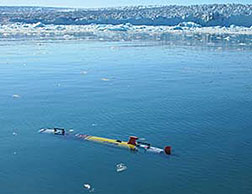- Number 406 |
- February 3, 2014
ORNL robotics sensors detect underwater explosive ordnance

An unmanned, autonomous underwater
vehicle surveys a fjord in western Greenland.
ORNL researchers are working with the Navy
to automate analysis of sonar data.
Photo: Woods Hole Oceanographic
Institution (A.Kukulya).
Modern weapons technologies often keep members of the military out of harm's way by allowing them to perform missions from a distance. Researchers at the Department of Energy’s Oak Ridge National Laboratory are helping the military play defense from a distance, as well.
Dan Archer and Thomas Karnowski, along with their team of scientists, are working with the Navy and the Woods Hole Oceanographic Institution to continue the development of unmanned, autonomous underwater vehicles with sensors that can scan areas, detect anomalies and differentiate between objects—like a wrench and a hammer versus an explosive mine.
“It’s a difficult problem because if you have a wrench and a hammer—fine—you can distinguish those,” Archer said. “But throw a bunch of other stuff on the table and then try to find the tools amongst the clutter and distinguish them from one another.”
Underwater machine vision can use both visual and sonar data. However, in depths greater than 15 feet, water filters the visible light spectrum, making a red object appear gray. Combine that with sand, salt, seaweed, current and bubbles, and accurate perception becomes difficult.
As a result, scientists are emphasizing the collection and processing of sonar data. During a mission, vehicles may collect many hours of data that will be analyzed by humans looking at each frame searching for an anomaly. The idea is to automate this process using machine vision embedded in efficient computational resources.
Supported by laboratory funding in collaboration with an Office of Naval Research-funded project, Karnowski analyzes the visual and sonar data and is developing an algorithm to make data analysis a more efficient process. With an efficient algorithm, the unmanned underwater vehicle can use the algorithm to understand what is being seen, eliminating the need for human workers doing their best to sift through hours of data.
“That’s the whole idea,” Archer said. “How do we apply our scientific expertise developed in other areas to enhance national security in an automated fashion that will become more efficient and cost less over time? All the science that goes into that is the key.”
However, these sensors don’t stop at just recognizing different objects—the goal is to understand them. The next step is a merging of the sensor analysis with the controls of the vehicle.
“So you have an idea of how to make a peanut butter and jelly sandwich, and you write that all down,” Archer said. “Get the bread, peanut butter, jelly … but what happens if the knife is not in the drawer? You’re done. So the idea is that, the knife is not there — react to it and automatically reprogram the mission. We want to take our sensor data, pull it apart, and use it to make actionable decisions and then have the vehicle react on those decisions.”
Using the data from the multiple sensors (like depth, speed and heading), the onboard processors can make sense of all the information at one time in order to lead more efficient missions and relay the information back to whoever is looking at the data.
“Mine fields are real and they are dangerous,” Archer said. “If someone’s trying to protect something in the ocean, they throw mines out—as well as a great number of other things that may look like a mine. How do you know that’s actually a mine? If you’re putting mines in the ocean, you don’t have to put explosives in them.
“To deter an adversary, you have to make the risk of potential mission failure outweigh the ‘reward’ of getting through. To accomplish this, you may throw all kinds of stuff out there because every item gives a return signal that someone has to analyze,” Archer said.
The wars and defense of the future are not human oriented, but robotics oriented. For robots to perform their mission of safety and security they have to have sensors embedded and the work at ORNL will provide those sensors. With safety at the forefront of robotics design, these are the droids we are looking for. — Dylan Platz
Submitted by DOE’s Oak Ridge National Laboratory
